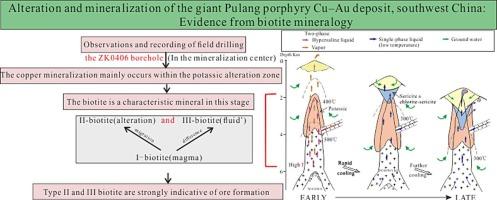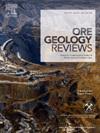中国西南巨型普朗斑岩型铜金矿床的蚀变和矿化:生物矿物学证据
IF 3.2
2区 地球科学
Q1 GEOLOGY
引用次数: 0
摘要
普朗斑岩铜金矿床是盖扎斑岩带中最大的印度洋斑岩铜矿床。岩浆和热液生物岩晶体广泛分布于矿床中部的矿体中。确定这些生物岩晶体的成分有助于我们了解成矿流体和成矿过程。在此,我们介绍了从 ZK0406 钻孔采集的生物岩样本的化学分析结果,该钻孔穿越了矿体中心和不同的蚀变带。我们确定了三种类型的生物岩(I 型、II 型和 III 型)。I 型生物黄铁矿是原生岩浆生物黄铁矿,周围有少量黄铜矿。II 型生物黄铁矿是被黄铜矿和黄铁矿包围的蚀变型生物黄铁矿。II 型斜长石的边缘和裂隙面通常被绿泥石所取代。III 型斜长石是热液斜长石,沿裂隙分布在斑岩中,与大量黄铜矿和黄铁矿伴生。这三种类型的黑云母都是镁黑云母。使用 I 型生物沸石晶体成分得出的地温计和氧压计结果表明,普朗矿床的岩浆温度为 720-766 ℃,氧富集度为 FMQ+2.3 至 FMQ+3.2。根据三种生物岩的成分估算出的熔体/流体富集度表明,在普朗矿床的钾长石蚀变阶段存在的流体可能对铜和金具有较高的运移能力。蚀变的结果是,铝和铁在 I 型生物岩中富集,而硅、钛、镁和纳则被浸出,然后先形成 II 型生物岩。III 型黑云母晶体的铜和钾含量较高,是在钾长石蚀变过程中形成的。将这些数据与实地观察相结合,表明铜的富集与 II 型和 III 型生物岩密切相关,它们形成于钾硅酸盐蚀变阶段,即普朗矿床的主要成矿阶段。本文章由计算机程序翻译,如有差异,请以英文原文为准。

Alteration and mineralization of the giant Pulang porphyry Cu–Au deposit, southwest China: Evidence from biotite mineralogy
The Pulang porphyry Cu–Au deposit is the largest Indosinian porphyry Cu deposit in the Geza porphyry belt. Magmatic and hydrothermal biotite crystals are widely distributed across ore bodies in the central part of the deposit. Determining the compositions of these biotite crystals can help us to understand the ore-forming fluids and processes. Here we present chemical analyses of biotite from samples collected from the ZK0406 borehole, which traverses the center of the ore bodies and the various alteration zones. We identified three types of biotite (types I, II, and III). Type I biotite is primary magmatic biotite and is surrounded by limited chalcopyrite. Type II biotite is alterated biotite surrounded by chalcopyrite and pyrite. The edges and cleavage planes of type II biotite are commonly replaced by chlorite. Type III biotite is hydrothermal biotite distributed in porphyries along fissures and is associated with large amounts of chalcopyrite and pyrite. All three biotite types are Mg-biotite. Geothermometer and oxybarometer results using the compositions of the type I biotite crystals suggest that the magmas in the Pulang deposit had temperatures of 720–766 °C and oxygen fugacities of FMQ+2.3 to FMQ+3.2. The melt/fluid fugacities estimated using the compositions of the three biotite types suggest that the fluids present during the Potassic alteration stage may have had the high transport capacity for Cu and Au in the Pulang deposit. As a result of alteration, Al and Fe were enriched in the type I biotite, whereas Si, Ti, Mg, and Na were leached, then foremed type II biotite. Type III biotite crystals have high Cu and K contents and formed during Potassic alteration. Combining these data with field observations suggests that the Cu enrichment was closely related to the type II and III biotite, which formed during the potassic–silicate alteration stage; i.e., the major ore-forming stage of the Pulang deposit.
求助全文
通过发布文献求助,成功后即可免费获取论文全文。
去求助
来源期刊

Ore Geology Reviews
地学-地质学
CiteScore
6.50
自引率
27.30%
发文量
546
审稿时长
22.9 weeks
期刊介绍:
Ore Geology Reviews aims to familiarize all earth scientists with recent advances in a number of interconnected disciplines related to the study of, and search for, ore deposits. The reviews range from brief to longer contributions, but the journal preferentially publishes manuscripts that fill the niche between the commonly shorter journal articles and the comprehensive book coverages, and thus has a special appeal to many authors and readers.
 求助内容:
求助内容: 应助结果提醒方式:
应助结果提醒方式:


